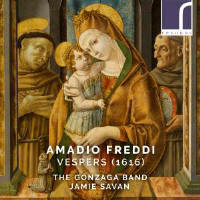Texte paru dans: / Appeared in:
Resonus |
|
|
Reviewer: J.
F. Weber Amadio Freddi (c. 1580–1643) adds one more composer to the Fanfare Archive. His biography as found in three important encyclopedias of music (British, German, Italian) abounds in confusion, so the director of this ensemble has tried to reconcile the conflicting data in his notes. He begins by choosing 1580 over 1570 for his birth year (only calculated from his age at death) because his first position was singing treble at San Antonio in Padua in 1592. He published a madrigal in 1598, became a priest in 1604, and published the present Vespers with Compline and a Mass in 1616, a significant echo of Monteverdi’s monumental work of 1610. He had left San Antonio in 1614, moving to Treviso cathedral as maestro, where he remained until 1627. The Ghirlanda sacra of 1625, a collection that included works by Monteverdi, contained two of his works recorded here, Cognoscam te Domine and Salve Regina. He spent the next seven years as maestro at the Vicenza cathedral. The Ave maris stella reconstructed on this disc was published in his final collection during this time. The Vespers of the title comprises five psalms and canticle that form the structure of the service. (They betray the same problem as Monteverdi’s Vespers of 1610, a set of psalms for Vespers of the Blessed Virgin that does not match the modes of the antiphons for any liturgical occasion.) In addition to these nine tracks, nine other tracks contain the music of the six other composers listed, half of them active at San Marco. (He spent his whole life in the Veneto.)
The resemblance of Freddi’s psalms and canticle to Monteverdi is more than coincidental, for he must have been aware of the 1610 publication. The psalms are spaced out by instrumental works except for Grandi’s Tota pulchra es (with Newton as the soloist) after the second psalm and Cognoscam te, Domine (with Thomas Herford as soloist) after the fourth psalm. The Salve Regina (with Newton again) comes before the canticle rather than after, probably because the Magnificat makes a bigger climax to the program. The sequence of pieces unfolds similarly to many other reconstructions of Vespers for this period. The voices are lovely (a colleague compared Newton to Emma Kirkby) and the instrumental playing is accomplished. The band has mastered the Italian Baroque style to a high degree, and Savan knows the repertoire so well that he can find something to fit each slot in his program. Of the other singers, Steven Harrold’s name leapt out as a familiar one that can be found in every British vocal ensemble.
All the
Freddi works are first recordings except Cognoscam te, Domine and
Salve Regina, though I can’t find them elsewhere. Grandi’s Tota pulchra
es was sung by Robert Crowe (35:1) and Eva Lebherz-Valentin (17:3). The
Gonzaga Band includes here only six singers, a violin, a cornett, and an
organ. Formed in 1997, the core members are Savan, the soprano Faye Newton,
and Steven Devine at the organ, with other members added as needed. Their
previous issue on this label was reviewed here (42:3), along with one of
their two previous Chandos records (33:3). If you are looking for offbeat
Baroque repertoire with a familiar ring to it, you will enjoy this fine
production. | |
|
|
|
|
|
|
|
Cliquez l'un ou l'autre
bouton pour découvrir bien d'autres critiques de CD |
|




